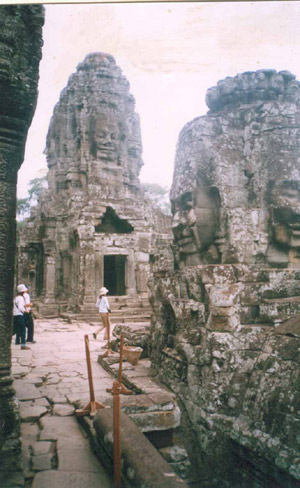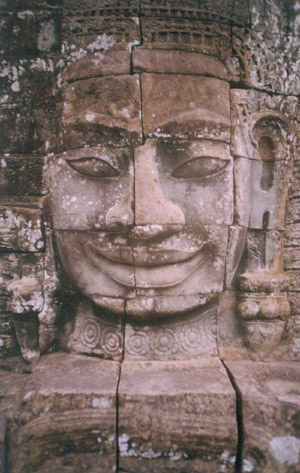Travel
Parallel U
pt. II
2002-06
Number 33–Angkor Finally
After two and a half years in Cambodia, I finally made it to Angkor, world’s largest religious site. I was stymied by not having the proper combination of time and money, that is, at least five free days – two for
 transit back and forth and three to wander the temples – and an extra hundred dollars. A three day pass to the archeological park costs $40 and until recently – 2003 – the road from Phnom Penh to Siem Reap, the gateway town to the temples, was so bad there were no buses. There was always the boat, but at $25 each way... well it all added up.
transit back and forth and three to wander the temples – and an extra hundred dollars. A three day pass to the archeological park costs $40 and until recently – 2003 – the road from Phnom Penh to Siem Reap, the gateway town to the temples, was so bad there were no buses. There was always the boat, but at $25 each way... well it all added up.
The only land alternative was a hot, dusty, grueling, more than 12 hour journey in the back of a crowded pickup truck over a maximum 20 mph severely pockmarked dirt track. Today the road is either paved, or graded on the way to pavement and the six hour, 200 mile (315 km) journey sets you back $4. In fact, I could’ve gone when I was in Cambodia in 1994, but back then the boat was occasionally getting shot at so I played it safe.
Also I usually wound up only having the necessary time during holidays and when everybody else goes and that’s definitely not when you want to be there. Besides it’s not something you can rush; I spent close to 15 hours at the temples spread over three days and saw barely more than half of them, though, of course, I did visit the most impressive ones. Even the average ones are spectacular. They’re entirely constructed of cut and fit stone with nearly every exposed surface intricately carved. They date from the 8th to 12th centuries.
While most of the temples are concentrated in a 10 square mile area, the park actually covers at least 5 times that space with a few additional sites further a field.

Angkor Wat, the largest of the temples, a representation of which appears on the Cambodian flag, is built in three levels and probably covers about ten acres all together. The highest level includes towers on each corner and a larger one, which stands 60 to 80 feet above the platform, in the center. By the way, there are still people lighting incense and praying in many places in the temples.
When I arrived at the second level, I saw people up top – the highest platform sits about 40 feet above the second level – but the only way there, as far as I could tell at the time, were these very steep stairways. There are nine all together so I walked around a bit to find one in reasonable shape. After a stone has been exposed to the elements for a millennium or so it starts to lose its original shape and become rounded. So... steep stairway, high, narrow, rounded steps and... definitely quickens your heart beat a little.
Nice thing about the third world is that you’re free to clamber over many places that would be off limits in litigation-happy USA. Going up was not so much of a problem because you get to hold on and see where you’re going and you don’t have to look back. I was really not looking forward to going down; so, phew, was relieved to discover a railing on one of the stairways with firm square concrete steps to stand on. Had to be; there were kids and real oldsters up there who I couldn’t believe were going to descend the way I had ascended.
Even the moat that surrounds the Angkor temple had to be a monumental task. More than 100 meters wide, five deep about three kilometers long, it is faced in stone steps on both inside and outside. The cap to the steps consists of stones that are 3 feet by 4 feet by one foot thick with exposed sides carved.
The second temple in importance is the Bayon and I’m including pictures of it. It has 54 towers, each including four giant faces – of one of the early kings – oriented to the cardinal points of the compass – supposedly to guard against enemies. It’s a face you can’t help but love and interestingly each is a little different.

It’s only in those parts of the temples that are totally sheltered from the elements that the intricacy of the carving can be seen and made me wonder what they might have looked like in the original and in turn reminded me of an archeological site I once visited in India. In the largest, most impressive temple on that site – the Elora caves about 400 miles east of Mumbai, aka Bombay, which includes 35 Buddhist and Hindu temples carved out of solid rock – there were a few small and well protected nooks where the original concept could be seen. This was actually not a cave but a large temple carved out of rock, so it was exposed to the elements. Whereas most of the temple was old weathered stone, the sheltered spots included brightly colored graphics on smooth plaster. What an amazing sight it must have been in the original, considering how breathtakingly impressive it was in its worn, rounded and washed out state.
Many parts of Angkor are being restored, though it can’t be taken back to the original. Wood beams and occasionally concrete are used to keep parts from structurally failing and some buildings on their way to toppling are being righted. But they don’t replace the intricate carvings and the only stones they discard are ones that have irretrievably deteriorated so you have individual new stones with sharp edges and no carvings intermixed with the rounded weathered ones.
I couldn’t help imagining what it would cost to bring one back to original or create one from scratch and I came up with billions of dollars. It’ll never happen but it would just be so far superior to see one as it looked fresh and new.
One of the nicest parts of the park is the inclusion of wide expanses of natural forest. This is probably the only place in Cambodia where a decent forest reserve is actually protected from poachers and such. I saw no complete canopy, but there are many beautiful trees in the one to two meter diameter range, which here in the tropics means 150 to 300 years old. As a condition of receiving international help, Cambodia had to agree to an absolute prohibition on development anywhere nearby so it’s a minimum 4 miles from the temples to the nearest commercial building.
The first day I took a tuk-tuk, the Thai word for 3-wheel taxi, which here is actually a motorcycle-pulled trailer. They are beautifully painted and spiffed out compared to equivalent vehicles elsewhere in Cambodia. I went the week after the Khmer New Year holiday so traffic was very light and I felt no concern renting a bicycle for the next two days of temple-hopping. Traffic is so dense and unruly in Phnom Penh that I’d not feel comfortable two-wheeling it in the big city but at Angkor, at a leisurely pace on flat terrain on a trusty one-speed, it was just the ticket in spite of temperatures in the mid nineties – the second day on the bike I did about 15 miles.
It isn’t just the tuk-tuks that are classily done up, the whole town of Siem Reap, population about 50,000, is one cutesy, clean (everybody has garbage containers – often a wicker basket – as opposed to PP where one can see piles of garbage in the street) tourist town. Aided by an open skies policy, many people fly direct to SR – from all the major regional cities – and never see any other part of Cambodia. Considering the prestige of the temples, there are several 5-star hotels. And it’s booming; in just the last year 1000 hotel rooms were added to 6000 existing rooms.
But it’s still Cambodia... poverty, amputees, beggars – more aggressive than in other parts of Cambodia, probably stoked by the level of wealth they see all around them – and vendors helloing you to death trying to get your attention and you to part with a little of your money... as well as a reasonable every day level of Khmer style chaos.
I was sitting at a sidewalk cafe when an obviously beggar woman approached. Before even looking very closely I waved her off, having just refused five young boys aged four to eight because I didn’t have any small monies. I give quite often but don’t think it’s wise to give more than very small amounts, but this woman not only had a baby in a sling and a tot walking beside her but she was missing an arm and a leg. Ouch. She sat down on the sidewalk nearby, big smile and all, without harassing me. I normally never give more than 5 cents, usually half that, but the smallest money on me was 25 cents so I hesitated to cough up until two girls about 5 to 8 years old came up to her, obviously also her kids, seemingly to report on how much money they’d rounded up on their own.
That woman had twice as many kids as limbs! How does something like that not harangue your heart strings? And you thought you had troubles. And she was still smiling! Welcome to Parallel U!